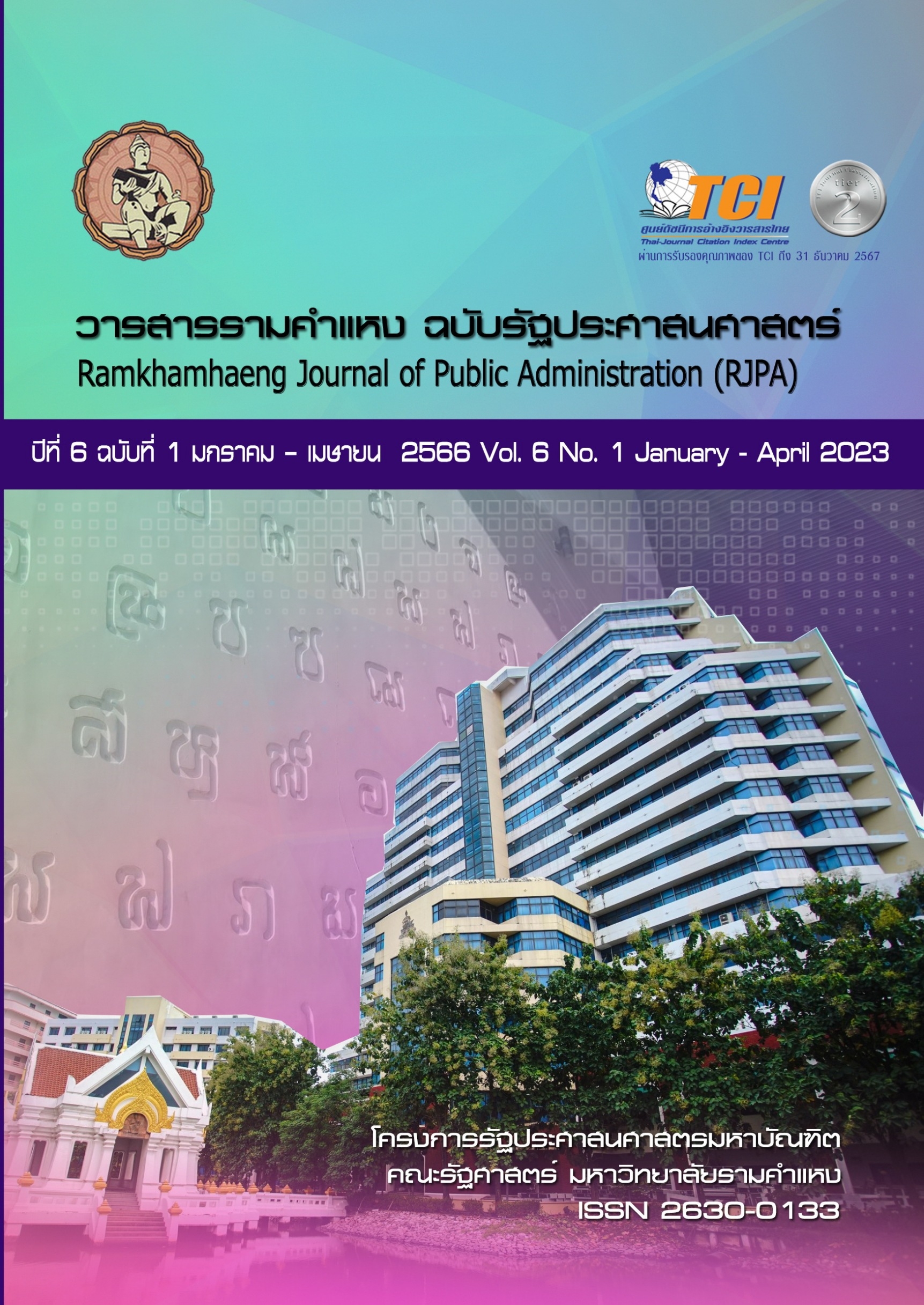The role and maintenance of military power and political elite in Myanmar from 1948 – 2010
Keywords:
Myanmar, Tatmadaw, Moderator, Guardian, RulerAbstract
This objectives of the study were to explore the context, origin, environmental factors of the political power of the military and the political elite, and to study the role and power retention of the military and the political elite in Myanmar during 1948-2010. It is a qualitative research method, using historical methods to study and explore data. It reveals that the political power of the military and political elites is due to diversity. ethnicity, belief, political ideology colonialism and world politics which resulted in continual struggle for political power of various groups since the past. Consequently, the military came to take political power as well as other political elites. In addition, the role and political power maintenance of the military and political elites of Myanmar during 1948-2010 according to Eric Nordlinger’s theory framework analysis found that: 1) during the period 1948-1962, during the period of an independent national state Internal politics are volatile. Racial and political ideology issues and Parliament is inefficient. In addition, the civilian government of Mr. U Nu unstable. There was a division in the country, requiring the strength of the army (Tatmadow) to maintain political balance. behind as "Mediators" 2) During 1962-1988, after winning and returning to government again, U Nu was unable to maintain his power. Because the army has couped the government of U Nu, leaving General Ne Win, the leader of the army, to rule the country alone during that period. During this period, the military has played a leading role in all dimensions of society, especially in politics, thus making the role of the military during this period as “Ruler” and 3) During 1988-2010, Myanmar's military government was constantly under pressure from the West. Including internal resistance from students. As a result, a new generation of military officers seized power from General Ne Win, who adapted the role of the army to maintain his political power. Therefore, the 2008 constitution was drafted and used as a tool to maintain the military's political power. When political power was transferred from the junta to a civilian government through general elections in 2010 under the military constitution, The military or the army has also assigned itself to continue to hold power as the "Guardian" of Myanmar itself.
References
กฤติธี ศรีเกตุ. (2564). นัตพม่ากับการเมืองวัฒนธรรม: ความสัมพันธ์เชิงอานาจทางการเมืองวัฒนธรรมในพื้นที่ความเชื่อเรื่องนัตในประเทศเมียนมา. วารสารสันติศึกษาปริทรรศน์ มจร., 9(5), 1,820-1,839.
ชาญวิทย์ เกษตรศิริ. (2544). พม่า: ประวัติศาสตร์และการเมือง. กรุงเทพมหานคร: มหาวิทยาลัยธรรมศาสตร์, มูลนิธิโครงการตาราสังคมศาสตร์และมนุษยศาสตร์.
ลลิตา หาญวงษ์. (2563, กุมภาพันธ์ 14). ไทยพบพม่า ตอน ออง ซาน กับรัฐพม่าสมัยใหม่ (5). ค้นเมื่อ 14 กุมภาพันธ์ 2563, จาก https://www.matichon.co.th/columnists/news_1967470
วาทิน ศานติ์ สันติ. (2556). พม่า: ภายใต้การปกครองของอังกฤษ และปัญหาการภายหลังได้รับเอกราช. ค้นเมื่อ 24 มกราคม 2564, จาก https://www.gotoknow.org/posts/309090.
วิรัช นิยมธรรม. (2554). มโนทัศน์ทางการเมืองของรัฐพม่าบนพื้นที่สื่อรัฐบาลทหาร. กรุงเทพมหานคร: สานักงานคณะกรรมการส่งเสริมวิทยาศาสตร์ วิจัยและนวัตกรรม.
วีรศักดิ์ ฉัตรรุ่งนพคุณ. (2561). การรักษาอานาจของรัฐบาลทหารเมียนมา ค.ศ. 1988-2008. กรุงเทพมหานคร: มหาวิทยาลัยศรีนครินทรวิโรฒ, คณะสังคมศาสตร์.
ศิลปวัฒนธรรมออนไลน์. (2565). 2 มีนาคม 1962 “เนวิน” ทารัฐประหาร เปลี่ยนพม่าเป็น “ฤาษีแห่งเอเชีย”. วันนี้ในอดีต. ค้นเมื่อ 4 มิถุนายน 2565, จาก https://www.silpa-mag.com/this-day-in-history/article_6966
เอนกชัย เรืองรัตนากร. (2563). ธุรกิจกองทัพกับการเปลี่ยนผ่านการทางเมืองในเมียนมา ค.ศ. 1958-2020. ดุษฎีนิพนธ์รัฐศาสตรดุษฎีบัณฑิต, จุฬาลงกรณ์มหาวิทยาลัย.
Alfred, S. (1973). Authoritarian Brazil: Origins, politics, and future. New Haven, CO: Yale University Press.
Arendshorst, J. (2009). The dilemma of non-interference: Myanmar, human rights, and the ASEAN charter. Journal of Northwestern Journal of International Haman Rights, 2(2), 101-121.
Callahan, M. P. (2003). Making enemies: War and state building in Burma. New York: Cornell University Press.
Charney, M. W. (2009). History of modern Burma. London: Cambridge University Press.
Crouch, M. & Ginsburg, T. (2016). Between endurance and change in South-East Asia: The military and constitutional reform in Myanmar and Thailand. International Institute for Democracy and Electoral Assistance.
Finer, S. E. (2006). The man on horseback: The role of the military in politics. New York: Praeger.
Kudo, T., & Kumagai, S. (2011). The United States and Japan: Assisting Myanmar’s development. Washington, DC: Sasakawa Peace Foundation.
Martin, M. F. (2010). Burma’s 2010 elections: Implications of the new constitution and election laws. Washington, DC: Congressional Research Service.
Moe, K. Z. (2017). Author discusses martyrs’day assassination of Aung San. Yangon, Myanmar: The Irrawaddy.
Nordlinger, E. A. (1977). Soldiers and politics: Military coups and governments. Englewood Cliffs, NJ: Prentice Hall.
Oo, Z. N. (2018). Myanmar parliaments can change really democracy. Retrieved March 8, 2020, from https://www.academia.edu/9834322 /Myanmar_Parliament/can/really/change
Silverstein, J. (1977). Burma: Military rule and the politics of stagnation. London: Cornell University Press.
Taylor, E. M. (2013). Nations on the move: Burmese migration to Australia. School of Historical and Philosophical Studies, Faculty of Arts, The University of Melbourne.
Downloads
Published
How to Cite
Issue
Section
Categories
License
Copyright (c) 2025 ธนันท์วัฒน์ สภานุรัตน์, กฤติธี ศรีเกตุ, พัด ลวางกูร

This work is licensed under a Creative Commons Attribution-NonCommercial-NoDerivatives 4.0 International License.


